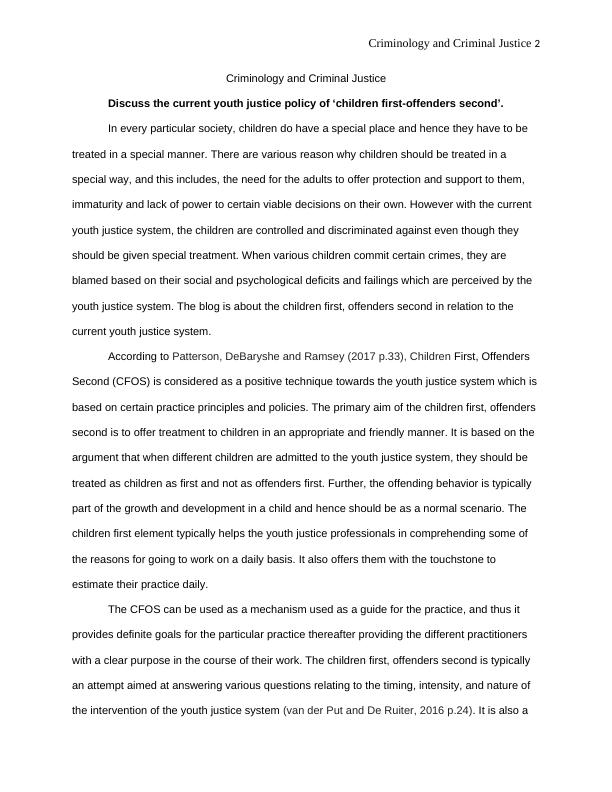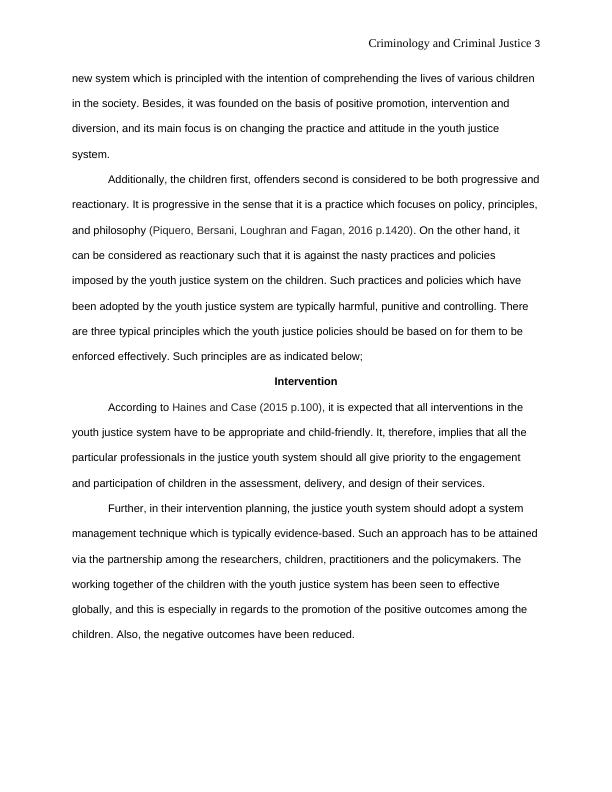Children First, Offenders Second: A Positive Technique Towards Youth Justice System
Added on 2023-05-31
6 Pages1565 Words183 Views
Criminology and Criminal Justice 1
CRIMINOLOGY AND CRIMINAL JUSTICE
by (Student’s Name)
Professor’s Name
Institution
Location of Institution
Course
Date
CRIMINOLOGY AND CRIMINAL JUSTICE
by (Student’s Name)
Professor’s Name
Institution
Location of Institution
Course
Date

Criminology and Criminal Justice 2
Criminology and Criminal Justice
Discuss the current youth justice policy of ‘children first-offenders second’.
In every particular society, children do have a special place and hence they have to be
treated in a special manner. There are various reason why children should be treated in a
special way, and this includes, the need for the adults to offer protection and support to them,
immaturity and lack of power to certain viable decisions on their own. However with the current
youth justice system, the children are controlled and discriminated against even though they
should be given special treatment. When various children commit certain crimes, they are
blamed based on their social and psychological deficits and failings which are perceived by the
youth justice system. The blog is about the children first, offenders second in relation to the
current youth justice system.
According to Patterson, DeBaryshe and Ramsey (2017 p.33), Children First, Offenders
Second (CFOS) is considered as a positive technique towards the youth justice system which is
based on certain practice principles and policies. The primary aim of the children first, offenders
second is to offer treatment to children in an appropriate and friendly manner. It is based on the
argument that when different children are admitted to the youth justice system, they should be
treated as children as first and not as offenders first. Further, the offending behavior is typically
part of the growth and development in a child and hence should be as a normal scenario. The
children first element typically helps the youth justice professionals in comprehending some of
the reasons for going to work on a daily basis. It also offers them with the touchstone to
estimate their practice daily.
The CFOS can be used as a mechanism used as a guide for the practice, and thus it
provides definite goals for the particular practice thereafter providing the different practitioners
with a clear purpose in the course of their work. The children first, offenders second is typically
an attempt aimed at answering various questions relating to the timing, intensity, and nature of
the intervention of the youth justice system (van der Put and De Ruiter, 2016 p.24). It is also a
Criminology and Criminal Justice
Discuss the current youth justice policy of ‘children first-offenders second’.
In every particular society, children do have a special place and hence they have to be
treated in a special manner. There are various reason why children should be treated in a
special way, and this includes, the need for the adults to offer protection and support to them,
immaturity and lack of power to certain viable decisions on their own. However with the current
youth justice system, the children are controlled and discriminated against even though they
should be given special treatment. When various children commit certain crimes, they are
blamed based on their social and psychological deficits and failings which are perceived by the
youth justice system. The blog is about the children first, offenders second in relation to the
current youth justice system.
According to Patterson, DeBaryshe and Ramsey (2017 p.33), Children First, Offenders
Second (CFOS) is considered as a positive technique towards the youth justice system which is
based on certain practice principles and policies. The primary aim of the children first, offenders
second is to offer treatment to children in an appropriate and friendly manner. It is based on the
argument that when different children are admitted to the youth justice system, they should be
treated as children as first and not as offenders first. Further, the offending behavior is typically
part of the growth and development in a child and hence should be as a normal scenario. The
children first element typically helps the youth justice professionals in comprehending some of
the reasons for going to work on a daily basis. It also offers them with the touchstone to
estimate their practice daily.
The CFOS can be used as a mechanism used as a guide for the practice, and thus it
provides definite goals for the particular practice thereafter providing the different practitioners
with a clear purpose in the course of their work. The children first, offenders second is typically
an attempt aimed at answering various questions relating to the timing, intensity, and nature of
the intervention of the youth justice system (van der Put and De Ruiter, 2016 p.24). It is also a

Criminology and Criminal Justice 3
new system which is principled with the intention of comprehending the lives of various children
in the society. Besides, it was founded on the basis of positive promotion, intervention and
diversion, and its main focus is on changing the practice and attitude in the youth justice
system.
Additionally, the children first, offenders second is considered to be both progressive and
reactionary. It is progressive in the sense that it is a practice which focuses on policy, principles,
and philosophy (Piquero, Bersani, Loughran and Fagan, 2016 p.1420). On the other hand, it
can be considered as reactionary such that it is against the nasty practices and policies
imposed by the youth justice system on the children. Such practices and policies which have
been adopted by the youth justice system are typically harmful, punitive and controlling. There
are three typical principles which the youth justice policies should be based on for them to be
enforced effectively. Such principles are as indicated below;
Intervention
According to Haines and Case (2015 p.100), it is expected that all interventions in the
youth justice system have to be appropriate and child-friendly. It, therefore, implies that all the
particular professionals in the justice youth system should all give priority to the engagement
and participation of children in the assessment, delivery, and design of their services.
Further, in their intervention planning, the justice youth system should adopt a system
management technique which is typically evidence-based. Such an approach has to be attained
via the partnership among the researchers, children, practitioners and the policymakers. The
working together of the children with the youth justice system has been seen to effective
globally, and this is especially in regards to the promotion of the positive outcomes among the
children. Also, the negative outcomes have been reduced.
new system which is principled with the intention of comprehending the lives of various children
in the society. Besides, it was founded on the basis of positive promotion, intervention and
diversion, and its main focus is on changing the practice and attitude in the youth justice
system.
Additionally, the children first, offenders second is considered to be both progressive and
reactionary. It is progressive in the sense that it is a practice which focuses on policy, principles,
and philosophy (Piquero, Bersani, Loughran and Fagan, 2016 p.1420). On the other hand, it
can be considered as reactionary such that it is against the nasty practices and policies
imposed by the youth justice system on the children. Such practices and policies which have
been adopted by the youth justice system are typically harmful, punitive and controlling. There
are three typical principles which the youth justice policies should be based on for them to be
enforced effectively. Such principles are as indicated below;
Intervention
According to Haines and Case (2015 p.100), it is expected that all interventions in the
youth justice system have to be appropriate and child-friendly. It, therefore, implies that all the
particular professionals in the justice youth system should all give priority to the engagement
and participation of children in the assessment, delivery, and design of their services.
Further, in their intervention planning, the justice youth system should adopt a system
management technique which is typically evidence-based. Such an approach has to be attained
via the partnership among the researchers, children, practitioners and the policymakers. The
working together of the children with the youth justice system has been seen to effective
globally, and this is especially in regards to the promotion of the positive outcomes among the
children. Also, the negative outcomes have been reduced.

End of preview
Want to access all the pages? Upload your documents or become a member.
Related Documents
Evaluation Of Youth Justicelg...
|10
|2262
|53
Reflective Practices in Youth Justice Systemlg...
|15
|1223
|95
Should Juvenile Offenders Be Tried and Punished in A Court of Lawlg...
|7
|570
|395
Reflective Essay on Simulated Group Worklg...
|7
|1625
|440
